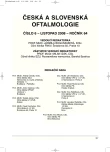Thrombolysis in Central Retinal Artery Occlusion using the Alteplasis
Authors:
R. Mach 1; J. Procházka 2
Authors‘ workplace:
Oční oddělení1 a Oddělení intenzivní medicíny2 Masarykovy nemocnice, Ústí nad Labem, ředitel MUDr. T. Indra
Published in:
Čes. a slov. Oftal., 64, 2008, No. 6, p. 245-248
Overview
Aim:
The systemic acute thrombolysis (fibrinolysis) is one of methods how to treat occlusion of the central retinal artery. We present our first results of this rarely used treatment.
Material and methods:
The patients were treated by means of i. v. infusion of the fibrinolytic alteplasis (plasminogen tissue activator, Actilyse®) with the dose 0.9 mg/kg of body weight, first as a bolus of 10 % of the dose, the rest was slowly applied while monitoring vital functions and coagulations parameters. The contraindications of the thrombolysis are especially tumors, bleeding, any surgery in last three months, and the brain stroke in the medical history, and diseases of the liver and kidneys. From November 2006 to April 2007, we treated 5 patients by means of thrombolysis; two patients with the occlusion of the temporal branch retinal artery (BRAO) with characteristic quadrant scotoma of the visual field and decrease of the visual acuity, and three patients with central retinal artery occlusion or hemi-occlusion (CRAO).
Results:
The central visual acuity improved in all patients the next day after the thrombolysis. Both patients with the branch retinal artery occlusion had visual acuity 1.0, the delay between the thrombosis and the treatment was more than 12 hours. In two out of three patients with the central occlusion the visual acuity improved from practical blindness to 0.66. The third patient came with the latency of more than 30 hours; he registered partial improvement shortly after the thrombolysis, but later, the visual acuity decreased again.
Conclusion:
The thrombolytic treatment is definitely an advantage comparing to the conservative treatment. According to many contraindications and possible complications, it is necessary to select the eligible patient carefully. The treatment can be done on specialized in-patient department with the possibility to monitor vital functions and coagulations factors during the treatment as well as after it. In four out of five of our patients, the treatment finished with fast recovery of visual acuity almost to the normal. The effect of the treatment was good up to 18 hours after the occlusion; after 30 hours it was bad.
Key words:
occlusion of the retinal artery, thrombolysis, plasminogen tissue activator, visual acuity
Sources
1. Augsburger, J.J., Magargal, L.E.: Visual prognosis following treatment of acute central retina artery obstruction. Br. J. Ophthal., 64, 1980 : 913–917.
2. Duker, J.S., Brown, G.C.: Recovery following acute obstruction of the retinal and choroidal circulations. A case history. Retina, 8, 1988 : 257–260.
3. Feltgen, N, Neubauer, A., Jurklies, B. et al.: Multicenter study of the European Assessment Group for Lysis in the Eye (EAGLE) for the treatment of central retinal artery occlusion: design issues and implications. EAGLE Study report no. 1. Graefes Arch Clin Exp Ophthalmol., 244, 2006 : 950–956.
4. Framme, C., Spiegel, D., Roider, J. et al.: Zentralarterienverschluss. Stellenwert der selektiven intraarteriellen Fibrinolyse. , 98, 2001 : 725–730.
5. Goldhaber ,S.Z., Bounameaux, H.: Thrombolytic therapy in pulmonary embolism. , 1, 2001 : 213–220.
6. Greven, C.M., Slusher, M.M., Weaver, R.G.: Retinal arterial occlusions in young adults. Am. J. Ophthalmol., 120, 1995, 6 : 776–83.
7. Hattenbach, L.O.: Lysistherapie bei retinalen Gefässverschlüssen. Ophthalmologe, 95, 1998 : 568–575.
8. Hayreh, S.S., Kolier, H.E., Weingeist, T.A.: Central retinal artery occlusion and retinal tolerance time. Ophthalmology; 87, 1980 : 75–78.
9. Hayreh, S.S.,Weingeist, T.A.: Experimental occlusion of the central artery of the retina. IV: Retinal tolerance time to acute ischaemia. Br. J. Ophthalmol., 64, 1980 : 818–825.
10. Kase, C.S., O‘Neal, A.M., Fisher, M. et al.: Intracranial hemorrhage after use of tissue plasminogen activator for coronary thrombolysis. 112, 1990 : 17–21.
11. Kaftan, J., Wang, D.Z., Reddy, C.: Intravenous recombinant tissue-type plasminogen activator thrombolysis in treatment of central retinal artery occlusion. Arch. Ophthalmol., 120, 2002 : 1234–1236.
12. Mach, R., Kessler, P., Rozsíval. P. et al.: Die lokale Fibrinolysistherapie bei Trombosen der Arteria centralis Retinae. Folia Ophthalmol., 16, 1991 : 17–19.
13. Mach, R., Kessler, P., Sušický, P. et al.: Trombolýza arteriální sítnicové okluse urokinázou. Čs. Oftalmol., 48, 1992 : 42–47.
14. Padolecchia, R., Puglioli, M., Ragone, M.C. et al.: Superselective Intraarterial Fibrinolysis in Central Retinal Artery Occlusion. Am. J. Neuroradiol., 20, 1999 : 565–567.
15. Pettersen, J.A., Hill, M.D., Demchuk, A.M. et al.: Intra-arterial Trombolysis for Retinal Artery Occlusion: The Calgary Experience. Can. J. Neurol.Sci., 32, 2005 : 507–511.
16. Richard, G., Lerche, R.C., Knospe, V.: Treatment of retinal arterial occlusion with local fibrinolysis using recombinant tissue plasminogen activator. 1999 : 768–773.
17. Schmidt, D.P., Schulte-Montig, J., Schumacher, M.: Prognosis of Central Retina Artery Occlusion: Local Intraarterial Fibrinolysis versus Konservative Treatment. Am.J. Neuroradiol., 23, 2002 : 1301–1307.
18. Schmidt, D., Schumacher, M., Wakhloo, A.K.: Microcatheter urokinase infusion in central retinal artery occlusion. , 113,1992 : 429–434.
19. Weber, J., Remonda, L., Mattle, H.P. et al.: Selective Intra-arterial Fibrinolysis of Acute Central Retinal Artery Occlusion Stroke, 29, 1998 : 2076–2079.
20. Widimský, J., Malý, J. et al.: Akutní plicní embolie a žilní trombóza: patogeneze, diagnostika, léčba a prevence. Triton, Praha 2005, 381 s.
Labels
OphthalmologyArticle was published in
Czech and Slovak Ophthalmology

2008 Issue 6
Most read in this issue
- Orbital Tumors in Adults – a Decennary Study
- Intraoperative Floppy Iris Syndrome versus Lens-Iris Diaphragm Retropulsion Syndrome
- The Treatment of the Rubeosis of the Iris and the Neovascular Glaucoma in Proliferative Diabetic Retinopathy by Means of anti-VEGF
- Thrombolysis in Central Retinal Artery Occlusion using the Alteplasis
